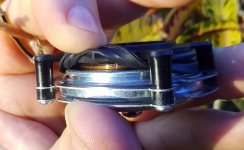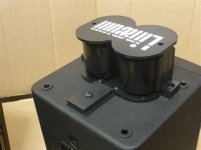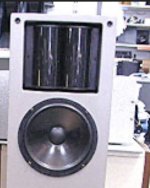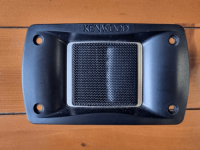I also tried this https://www.amazon.com/MT-Products-Diameter-Inches-Length/dp/B07KJFFL1R/ref=sr_1_1_sspa?crid=7CE7SA9ED0K1&keywords=styrofoam+hollow+rods&qid=1670758892&s=arts-crafts&sprefix=styrofoam+hollow+rod,arts-crafts,172&sr=1-1-spons&psc=1&spLa=ZW5jcnlwdGVkUXVhbGlmaWVyPUEyVTJNTE81T1E0TlkwJmVuY3J5cHRlZElkPUEwMzI3ODA5MkkxV0FGRzJUSEpJMiZlbmNyeXB0ZWRBZElkPUEwNzg0MzA4TFpYNjZOMTZPNThBJndpZGdldE5hbWU9c3BfYXRmJmFjdGlvbj1jbGlja1JlZGlyZWN0JmRvTm90TG9nQ2xpY2s9dHJ1ZQ==
I also tried using 2 exciters on a single styrofoam rod one at each end.
I also tried using 2 exciters on a single styrofoam rod one at each end.
What was the result?I also tried using 2 exciters on a single styrofoam rod one at each end.
Deconstructing the 32Q's show they don't incorporate a typical spider. The voice coil is glued to the plastic with arms that reach out and attach to the springs which become the "spider". Also there is the rubber boot which is also glued to the plastic underneath and directly beside where the voice coil is glued. (photo below)32Q's lack the higher frequencies. The DAEX30's are better then the 32Q's. The problem is they dont make an 8ohm version of the DAEX30s.
The strength of the 8 springs and the thick rubber boot all participate in holding them back from the highs. It looks as though the boot could be (carefully cut) removed from the equation without ill effect on the operation of the exciter and use only the lower 4 springs to keep the coil centered while allowing less resistance. (That boot may be keeping a lot of nasty resonance at bay?)
If I can't find a use for them then I'll go that route. I'm going to keep them as is for now and use them to experiment on hard materials, different forms of glass as chdsl is doing for sure, they may be just what glass needs.
Attachments
Last edited:
Those 32Q's are some out of the box thinking and reminded me of these.
Has anyone had a chance to check these out? If products even exist?
The world’s first fully balanced dual membrane driver technology
https://www.mayht.com/technology
Has anyone had a chance to check these out? If products even exist?
The world’s first fully balanced dual membrane driver technology
https://www.mayht.com/technology
Last edited:
Here's something quite interesting, right here in DiyAudio, one flat coil, flat magnets, curved flat panel into a cylinder (2 of them). Electricity goes through the flat coil, music comes out of the two cylinders. I saw this video quite sometime ago, somewhat forgot about it, until I saw it again here in diyAudio. It is called a Rubanoid, or ribbon-like. Don't see any ribbon, though. This work is real DIY, who understood the idea, and made a working model out of it. Maybe, some of us join our member in that thread?
A French engineer had found this idea in the 1980s, and as usual not commercially marketable to the general public. A Swiss company Audio Consulting appears to be making some speakers, and as usual, must be horribly expensive. Or, they are not producing any speakers right now. Any videos from them are 8 years old.
A French engineer had found this idea in the 1980s, and as usual not commercially marketable to the general public. A Swiss company Audio Consulting appears to be making some speakers, and as usual, must be horribly expensive. Or, they are not producing any speakers right now. Any videos from them are 8 years old.
Last edited:
The idea is from linaeum a dipole tweeter which is more or less omnidirectional.
in this way made as on top tweeters.
Also made as halves to use in closed speakers. Kenwood used them in the past.
the original linaeums were made of silk. later on these are made by optimus. they used a plastic film instead.
in this way made as on top tweeters.
Also made as halves to use in closed speakers. Kenwood used them in the past.
the original linaeums were made of silk. later on these are made by optimus. they used a plastic film instead.
Attachments
I found that thread today, but it looks like the guy had posted it in August this year. I saw that video in YT few months ago, but didn't understand much how it works, maybe didn't care to understand. 🙂 But, someone here mentioned flat coils, I searched flat coils in the internet, and that directed me to this diyAudio thread. It looks like that member had not found much interest here, and had left.
Anyway, flat coils, flat panels, distributed modes etc are of interest to us. Only, I am still trying to fathom, how the vibrations, this time not from one point travelling radially as with a excitor touching one point/area, travels in this curved flat panel. Now, it appears as travelling in parallel lines/waves along the surface, if at all there are any such waves. It is interesting why there is, or if there is, the same electromagnetic field at the beginning, in the centre or at the far bent turns. Or, why the sound is there, and not cancel each other? Would the sound still be there, if the panel not bend in to a cylinder|? Oh, questions galore!
I know for sure that I feel the vibrations more at the place of contact when the glass panel edge was held tightly over the excitor. I even had two excitors touching the glass panel edge (earlier posts). In both situations it wasn't easy to point out from which part of the panel music is coming from. I am thinking whether I could transfer the vibrations from the excitor(s) to a long horizontal channel, and then to the glass edge. This horizontal channel should be very stiff, not to bend by itself. Maybe that's what the Ammos students did. Anyway, I'll sleep over the matter. One day/morning, the reply will arrive. 🙂 I'll let the problem lie, without thinking/searching for the solution.
Anyway, flat coils, flat panels, distributed modes etc are of interest to us. Only, I am still trying to fathom, how the vibrations, this time not from one point travelling radially as with a excitor touching one point/area, travels in this curved flat panel. Now, it appears as travelling in parallel lines/waves along the surface, if at all there are any such waves. It is interesting why there is, or if there is, the same electromagnetic field at the beginning, in the centre or at the far bent turns. Or, why the sound is there, and not cancel each other? Would the sound still be there, if the panel not bend in to a cylinder|? Oh, questions galore!
I know for sure that I feel the vibrations more at the place of contact when the glass panel edge was held tightly over the excitor. I even had two excitors touching the glass panel edge (earlier posts). In both situations it wasn't easy to point out from which part of the panel music is coming from. I am thinking whether I could transfer the vibrations from the excitor(s) to a long horizontal channel, and then to the glass edge. This horizontal channel should be very stiff, not to bend by itself. Maybe that's what the Ammos students did. Anyway, I'll sleep over the matter. One day/morning, the reply will arrive. 🙂 I'll let the problem lie, without thinking/searching for the solution.
Sure, that's what the guy wrote in his first and only post. I dug a bit more. It is not about only the tweeters.The idea is from linaeum a dipole tweeter which is more or less omnidirectional.
in this way made as on top tweeters.
Also made as halves to use in closed speakers. Kenwood used them in the past.
the original linaeums were made of silk. later on these are made by optimus. they used a plastic film instead.
I am finding more and more vids on rubanoid in the net. The rubanoids I find in the net are actually ugly. There's only one question that an answer have to be found, that is how the sound travels through/from the bent panel, and whether the panel have to be bent to get the sound.
Someone here was taking about flat coils. Here's a link to a guy who knows quite a lot about flat coils. I used to watch his videos time to time, but maybe I didn't understand much, or maybe I didn't care to understand. Anyway, those who wants to, try to watch at least from 4-5 years ago.
This is the topic of my post 7420. The French engineer is François Deminiere, the speaker Janus50.. he said it is a ribbon speaker but more probably it is a bending wave one. His way to make the "exciter" with a flat voice coil might be a source of inspiration.Here's something quite interesting, right here in DiyAudio, one flat coil, flat magnets, curved flat panel into a cylinder (2 of them). Electricity goes through the flat coil, music comes out of the two cylinders. I saw this video quite sometime ago, somewhat forgot about it, until I saw it again here in diyAudio. It is called a Rubanoid, or ribbon-like. Don't see any ribbon, though. This work is real DIY, who understood the idea, and made a working model out of it. Maybe, some of us join our member in that thread?
A French engineer had found this idea in the 1980s, and as usual not commercially marketable to the general public. A Swiss company Audio Consulting appears to be making some speakers, and as usual, must be horribly expensive. Or, they are not producing any speakers right now. Any videos from them are 8 years old.
Made a note to myself: read your posts carefully and twice! 🙂This is the topic of my post 7420. The French engineer is François Deminiere, the speaker Janus50.. he said it is a ribbon speaker but more probably it is a bending wave one. His way to make the "exciter" with a flat voice coil might be a source of inspiration.
Yesterday, spent a lot of time listening to Joppe Peelan arguing. discussing with himself about rubanoides, planars, creating flat coils etc, and creating interesting stuff. Some of them I had seen before, but didn't have enough energy to keep on listening. Yesterday, I made myself get used to his way of speaking, and listen to him as carefully as I could. No World Cup match to distract helped. 🙂
Just imagine going through this for 23 mins! But, he's good.
Joppe is making life difficult for himself in that you can wind both tweeter and mid coils in parallel rather than split them into separate coils. He is doing this I guess because he wants to reduce the HF area to as close to a point as possible to help with dispersion but we don’t have that problem with a DML. Jope is a great experimenter and very generous with his discoveries.
Burnt.
Burnt.
Here, he makes a simple rubanoid tweeter membrane, and here, he finishes it and test it. Making the curve larger or smaller changes the results.
It is a flat paper bent into a curve with a long flat coil held between vertical flat magnets. There's a 'pistonic' motion. That pistonic motion is flat movement in one plane. Interesting how the distributed mode happens in the curved paper, if that happens at all. Also, don't see any vibrations along the surface of the curved paper. (There are many vids with music playing on his YT page.)
Also with the back curved element taken off, there's no worries about back wall reflections etc.
Pistonic motion in one plane, sound comes from a curved surface with one edge tightly fixed. And sound goes out everywhere.
In the 'normal' driver, pistonic motion is still the same, that is in one direction, but the points on bobbin top are moving on any plane.
Anyway, have to make one to check how it works. 🙂
It is a flat paper bent into a curve with a long flat coil held between vertical flat magnets. There's a 'pistonic' motion. That pistonic motion is flat movement in one plane. Interesting how the distributed mode happens in the curved paper, if that happens at all. Also, don't see any vibrations along the surface of the curved paper. (There are many vids with music playing on his YT page.)
Also with the back curved element taken off, there's no worries about back wall reflections etc.
Pistonic motion in one plane, sound comes from a curved surface with one edge tightly fixed. And sound goes out everywhere.
In the 'normal' driver, pistonic motion is still the same, that is in one direction, but the points on bobbin top are moving on any plane.
Anyway, have to make one to check how it works. 🙂
Oh, I didn't know he is member of diyAudio and that @spedge had mentioned of him right here in this thread. It's pretty hard to keep on track with everything. At least the semifinals are in the next two days. 🙂
Last edited:
No problem Chdsl. Difficult to focus on all the contents.Made a note to myself: read your posts carefully and twice! 🙂
Yesterday, spent a lot of time listening to Joppe Peelan arguing. discussing with himself about rubanoides, planars, creating flat coils etc, and creating interesting stuff. Some of them I had seen before, but didn't have enough energy to keep on listening. Yesterday, I made myself get used to his way of speaking, and listen to him as carefully as I could. No World Cup match to distract helped. 🙂
Just imagine going through this for 23 mins! But, he's good.
About Joppe's video : have you found the one explaining the etching technique of the alu flat coil and how this coil is then connected to some wires (alu is not the best friend for welding)?
PS : answer to my second question is in this video part 4 - How to make a simple Rubanoide tweeter - Membrane you pointed. See from time 12mn. The question now is what is the flux used... No question he is really inventive and skilled.
Last edited:
- Home
- Loudspeakers
- Full Range
- A Study of DMLs as a Full Range Speaker



